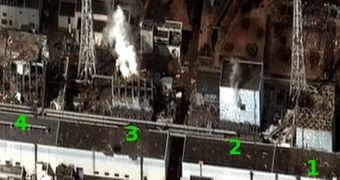Emergency responders in Japan have began using helicopters to try and maintain temperatures within manageable limits at reactor #3 a the Fukushima Daiichi nuclear power plant, some 250 kilometers (155 miles) away from Tokyo.
The situation at this particular building was degrading rapidly, and so authorities decided to intervene through whatever means possible. Flights began just before 9 pm EDT (2300 GMT) on March 16.
Originally, plans were drawn up so that the aircraft involved in this operation would begin flying on Tuesday, March 15. However, the sorties were postponed due to elevated levels of radioactivity around the target site, Japanese officials announced.
Given the reported rise of temperature inside reactor #3, it was decided that the matter could not withstand even the smallest delays. At the same time, authorities did some rumor control as well.
Speaking earlier today, representatives from the Tokyo Electric Power Company (TEPCO), the operator of the power plant and the Nuclear and Industry Safety Agency (NISA), the main body regulating nuclear power usage in Japan, said that news circulated about reactor #4 were false.
Reports in the media indicated over the past couple of days that there was a complete drainage of water from the used fuel pools that house the reactor's spent fissionable material. The spokesmen said that this was not the case, and that water levels remained relatively constant in the pool.
“We can’t get inside (#4) to check, but we’ve been carefully watching the building’s environs, and there has not been any particular problem,” told media Hajime Motojuku, a TEPCO spokesman.
NISA spokesman Takumi Koyamada added that temperatures were maintaining steady in the pools, at around 85 degrees Celsius. This type of spent fuel is generally kept at 30 degrees Celsius.
However, both officials mentioned the fact that radiation levels at Fukushima and in its immediate vicinity were dropping, from 75 millirem per hour at 0800 GMT on Wednesday to 24 millirem at 2000 GMT the same day.
At the same time, crews are working on getting power back online. They are installing cable to bring in critical electricity from surrounding areas, to power up the plant's cooling system pumps.
These are absolutely essential for cooling the reactor cores, which would otherwise suffer partial or total meltdowns, say analysts with the Massachusetts Institute of Technology (MIT) Nuclear Science and Engineering (NSE) Information Hub.
There are currently fears that this may have happened to reactor #2, whose fuel rods were completely exposed for a few hours on Monday, March 14.
The nuclear facility was damaged by the March 11 earthquake that struck Japan with a magnitude of 9.0 degrees. The subsequent tsunami that hit the installation caused additional damage, and authorities have been struggling to keep things in control ever since.

 14 DAY TRIAL //
14 DAY TRIAL //